» Home
» About
» Membership
» Journal
» Sparoza Garden
» Branches
» MGS Forum
» Seed Exchange
» Donations
» MGS Excursions
» Information
» Members' Gardens
» Book Reviews
» News & Views
» Contact
» Search
|
About the MGS
The Mediterranean Garden Society (MGS) is a non-profit making association founded in Greece in 1994 which acts as a forum for everyone who has a special interest in the plants and gardens of mediterranean climate regions. The forum operates through the quarterly journal, The Mediterranean Garden, with articles and book reviews almost exclusively written by members; this constantly up-dated web site; and, on a more local level, through events organised by branches formed in the countries where our members live and garden. The principles espoused by the MGS are demonstrated for the members’ benefit in an experimental garden just outside Athens on a property belonging to the Goulandris Natural History Museum and generously placed at our disposal.
The aims of the MGS as set out in the Charter were deliberately drafted broadly to cover all possible directions that the society might wish to go in its life. As an international society, the MGS has members in countries throughout the world and in many of them members have formed branches so that they can meet for various activities.
*NB The word "Mediterranean" with a capital M is used to denote the countries surrounding the Mediterranean Basin, while the uncapitalized word "mediterranean" is used to describe the type of climate shared by these countries and other regions of the world.
Why a 'mediterranean' garden society?
For many years gardening literature has been dominated by descriptions and illustrations of plants and garden designs suited to the climate of northern Europe and other temperate zones where so far there is no lack of water. Seduced by these images, mediterranean gardeners have struggled to produce approximations to 'English gardens' which are quite unsuited to the conditions of the mediterranean climate areas.
It is the goal of the Mediterranean Garden Society to develop alternatives, no less attractive or alluring, which are truly based on a mediterranean way of gardening. The plants to be used, as natives to the mediterranean climate areas of the world, will of necessity be more or less drought resistant. Waterwise gardening has to be one of the basic tenets in countries where summer drought can last for four months and more - areas where the cost of water can only increase and availability decrease.
A further principle is the protection and nurturing of the existing flora. A mediterranean plot where trees and shrubs grow slowly and tortuously is no place for fashionable 'make-overs'. Mature, existing trees offer immediate shade to both people and new plantings, and wildflowers lighten up the spring garden without any effort on the part of the owner. With a little flexibility existing plants can be worked into the design of the new garden.
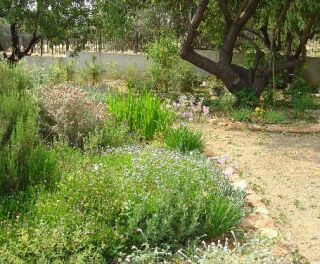
A new garden in an almond grove using stones from the
plot for edging and mediterranean plants.
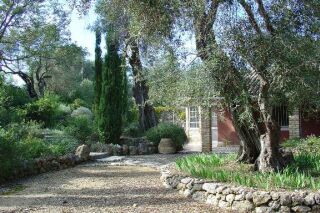
A mature garden in an olive grove using the same materials.
In fact, the design of the garden is where the principles of mediterranean gardening are rooted. Instead of rolling lawns and beds of plants all bursting into flower at once in the summer, a mediterranean garden is a more complex collection of hard surfaces of local natural and man-made materials, shaded areas, water features and plants flowering in turn for all twelve months of the year. In some parts of the garden scent will be more important than flowers for the number of mediterranean plants with scented leaves is amazing: not only herbs but geraniums, salvias, helichrysums, tanacetums and many more. Again, plant shape can be an important design feature, for instance many native mediterranean plants have a naturally cushion-like shape while the small leaves of plants like box, Pistachio and Teucrium fruticans make them ideal subjects for clipping.
Finally, the special needs of garden maintenance have to be faced. These centre on the subject of soil improvement, much more through mulching and composting than through digging.
The Mediterranean Garden
All these topics and many more feature in articles in The Mediterranean Garden, the journal which members receive four times a year and which is the major advantage of membership. The Editor, Caroline Harbouri, depends very largely on contributions from members who write from personal experience both of their own gardens and of the gardens and the countryside that they have visited. The articles are illustrated with the original drawings that make the journal so distinctive. Also included are book reviews, letters and news.
A Short History of the MGS
The beginning
In 1992 the British journal Hortus published 'Letter from Attica' by Derek Toms, in which he cited the problems of gardening in the Mediterranean. This prompted a letter from Trevor Nottle, the Australian garden consultant and writer, who pointed out that the problems faced by Mediterranean gardeners tended to be shared by others in similar climate zones elsewhere in the world. He had just begun to write a book on the subject and asked whether he could send Derek a questionnaire. Derek subsequently placed a letter in The European newspaper inviting other mediterranean gardeners to participate, and copies of the questionnaire were sent out some 30 people.
From their responses and ensuing correspondence, it became clear that gardeners throughout the region faced broadly similar problems, namely:
- Climate: summer drought, high temperatures, high winds, salt-laden winds on the coasts, frost risk at higher altitudes.
- Soils: often poor in nutrients, stony, alkaline, frequently only a thin covering over rock.
- Plants: a limited selection of plants suitable for local conditions available from nurseries, plants often imported and suitable only for temperate climates, inadequately labelled, many plants of Mediterranean origin not commercially available.
- Labour: a lack of horticultural training at all levels and hence a shortage of qualified labour.
- Information: very few books written specifically on Mediterranean gardening, the information in books written for temperate Europe and America being rarely applicable. (Note: in the years since 1994 this gap has been filled by the publication of quite a few books on Mediterranean or dry-climate gardening.)
- Design: the conventions of temperate landscape design are not always appropriate to the Mediterranean and new approaches to an indigenous garden style need to be explored.
- Contact: many gardeners struggle by trial and error in isolation.
All this suggested that some kind of regional network to share information and experience would be welcome. The idea was tentatively proposed to one or two people and evoked a favourable response. Then, early in 1994, Caroline Harbouri (one of the respondents to Trevor's questionnaire) took Derek to see the garden at Sparoza. This garden, created by Jaqueline Tyrwhitt nearly 30 years earlier and now the property of the Goulandris Natural History Museum, had been very much a pioneering effort; moreover, Jaqueline Tyrwhitt had kept a record of her experiences with a view to publishing them. Sally Razelou, custodian at Sparoza and herself a keen gardener, supported Derek's idea enthusiastically. Sparoza seemed a natural home for a ‘mediterranean’ gardening society.
The infant society was christened and a bulletin prepared setting out its aims. The next task was to publicise the project. This was a slow process but it was accelerated by the visit of Professor William Stearn to Sparoza that summer. Professor Stearn took back news of the nascent society to Hugh Johnson, editor of the RHS’s The Garden and its publication in that journal brought in a wave of enquiries. No money was available for advertising but the newly founded MGS was generously given mentions in a number of publications, including Hortus, Pacific Horticulture, Gardens Illustrated, The American Garden Journal, Giardini and The European.
In the meantime, we had embarked on the lengthy process of registering the society in Greece as a non-profit-making association. Twenty founder members were co-opted to sign the application (and subsequently the charter) and to put up the funds for the legal registration of the Society. Others who provided great support included Heidi Gildemeister, Trevor Nottle and Marina Adams, the UK-based landscape architect whose first commission on qualifying in 1963 had been the design of the garden at Sparoza. A charter was drawn up in June 1994. The society finally received official notice of registration in December 1994. On the 1st of January, 1995, the MGS opened its subscription membership.
The Journal
Starting life without financial backing or sponsorship, the MGS was very much a case of creating something from nothing. After issuing two 8-page newsletters, it was felt that the time had come to publish a quarterly journal and in the summer of 1995 the first issue of The Mediterranean Garden appeared, despite the society's precarious finances. The bank account was emptied to print and dispatch the first two journals - it was only in the second year that membership grew sufficiently to ensure a running surplus of cash over expenses. The first three issues were edited jointly by Derek Toms and Caroline Harbouri; thereafter Caroline was persuaded to take over as sole editor with Derek as the main illustrator. From an initial sixty-four pages the journal expanded in 1999 to eighty pages with a longer issue in January when the index for the previous year is included. The journal is now illustrated by the work of many talented members and Caroline Harbouri has continued as Editor with the assistance as proof-reader of Sue Vlassis.
Growth
By the end of 1995 there were 241 MGS members in 18 countries around the world. A year later membership stood at just over 500, and passed the 1500 mark in the year 2005 with members in 40 countries. Since then membership has fluctuated depending on the exchange rate of the Euro and the state of the world economy. Membership has not been confined to individuals: botanic gardens as far apart as Adelaide and Santa Barbara in California, universities and other societies have all joined the MGS. It was the aim of the fourth President, Cali Doxiadis, to encourage membership of the MGS beyond the conclaves of expatriates from northern climes to include gardeners native to the Mediterranean. Despite the potential language barrier, 'native Mediterraneans' now form a significant proportion of members.
Administrative Committee
Presidents - During the first months of the society's existence the various administrative roles were undertaken by Derek Toms and Sally Razelou but in December 1995, in accordance with our legal obligations, a five-member Administrative Committee was elected and Sally became the society's first President. Heidi Gildemeister (Spain) took over as President in October 1997, Katherine Greenberg (USA) in January 2001, Cali Doxiadis (Greece) in October 2004, Caroline Harbouri (Greece) in 2007, Jean Vaché (France) in 2010, Alisdair Aird (UK) in 2013, Caroline Davies (Australia) in 2016.
Vice Presidents and Councillors - John Rendall, who had himself lived at Sparoza for the ten years after Jacky Tyrwhitt’s death and kept her garden going, acted as Vice-President for nearly eleven years up to 2007. As a friend and adviser of Mrs Niki Goulandri of the Goulandris Natural History Museum, the owner of the Sparoza estate, he was instrumental in the negotiations to make Sparoza the legal seat of the MGS in 1995 and in getting a long-term lease for the MGS when it took over as tenant in 1999. John was followed as Vice-President by George Brumder in 2007, who was followed in turn by John Joynes in 2013. Councillors since 1998 have included Don Matthews, Irini Ramphou, Jean Vaché, Caroline Harbouri, Sally Beale and Jean-Pierre Bouchez.
Secretary and Treasurer - The routine graft of running the society in Greece is carried out by the Secretary and Treasurer. Barbara Diamantides was elected as Secretary in 1996 and worked initially with Dana Zangas as Treasurer and then from 1998 with Vivien Psaropoulou. Barbara and Vivien worked together during those important early years getting the MGS administration established. Barbara created a computerised database containing all the information about members and their payments - a system which was so adaptable and robust as to be still in use in 2014. Vivien set up a separate system so that there was double recording to limit errors. Fleur Pavlidis became Secretary in 2004 but Vivien stayed on heroically for a further three years during which time she set up a credit card payment system. When Fleur retired in 2010, Jane Taniskidou was elected Secretary and Jill Yakas Treasurer. Jill has worked to modernise the keeping of the MGS accounts and production of financial statements using the Accrual method of accounting. In 2013 Jill was joined by Vivien Psaropoulou as Secretary.
By 2001 the work of the Administrative Committee had become such that it was decided to get the three Reserve Members involved and they were subsequently invited to the AC Meetings and when necessary took on set tasks. As Reserves, Fleur Pavlidis, Davina Michaelides, Fulla Chapple and Heather Martin, for example, have been concerned in the organisation of the Annual General Meetings. Email messaging is used heavily between AC members, but those outside Greece are unable to participate actively in meetings unless they visit Athens. Fortunately, with the use of Skype, all AC members have been able to participate in meetings since 2008.
Branches
Faced with a widely scattered membership, the development of local branches was a logical step which Heidi Gildemeister took in 1997 and Katherine Greenberg continued throughout her presidency. At present the MGS has branches in the mediterranean-climate areas of Cyprus, Greece, Italy, Spain, Australia and the USA. Some members live outside the mediterranean climate areas but have their own local branches: in the German-speaking countries (Germany, Austria and Switzerland), the UK and Scandinavia. Each branch and group has its own programme of meetings, garden visits etc., and some have their own newsletters, Facebook pages and websites.
Internet presence
Another of Heidi Gildemeister's innovations was to get the MGS on to the internet. Seán O'Hara, at that time the Northern California Branch Head, had already set up a website for mediterranean plants. He agreed to add pages to his site for the MGS and made the original design. Subsequently, as the site expanded under the editorship of Fleur Pavlidis, it became necessary to employ a professional manager and since 2005 Jon Watts of Hereford Web Design has managed the site which has become the 'shop window' for the MGS. Jean Vaché succeeded as Web Editor in 2009 and instigated the setting up of two mini websites: first the official MGS website in Greek and second the official MGS website in French followed by the official MGS website in Italian in 2015 and the official MGS website in Spanish in 2016.
The possibility of creating an internet discussion forum for members and non-members was mooted in 2009 and was quickly set up under the professional guidance of Fred Carrie with Alisdair Aird, Fleur Pavlidis and Oron Peri as moderators. The MGS Forum is informative, friendly and the home of inspiring photographs and is much loved by its regulars.
Meanwhile the MGS Facebook page was also established by Alisdair Aird and gives another entrance to the world of the MGS.
Promotion of Principles
MGS members are introduced to the society's principles via the journal and the website and many of the events organised by the branches. In addition, the Annual General Meeting has become an opportunity for an educational as well as an administrative and social and gathering. Right from the beginning the first president, Sally Razelou, realised that for members to be persuaded to attend the General Assembly in Greece she would have to offer some kind of additional events. As the presidency passed outside Greece so the range of venues expanded - to Spain, France, Italy and Cyprus, across the Atlantic and the American continent to California and down to the southern hemisphere to Melbourne and Adelaide. From small beginnings, up to 120 members now participate in each AGM, learning how gardeners in countries other than their own handle the challenges of the climate and conditions. Also in 2007 the AGM in Athens was organised as a Symposium with workshops, panel discussions and evening lectures, the latter being open to the public and very well attended.
The promotion to the general public of the MGS principles of environment- and climate–compatible gardening is very important. Given the geographically scattered nature of the MGS membership it has been in the hands of the branches to take part in various local garden fairs and symposia, to arrange lectures open to the public and to promote the MGS way of waterwise gardening in general. So that information can be available for distribution at these events, a series of informative leaflets on various practical aspects of Mediterranean gardening was initiated during the presidency of Caroline Harbouri. Each one is translated into the other Mediterranean languages and offered freely at public events.
In 2005 it was suggested by the South Australia Branch that the MGS should make a token donation to the Adelaide Botanic Garden as a sign of support for the work being undertaken. Subsequently the idea of an annual donation was adopted and it has been awarded every year to an institution chosen by the hosts of the Annual General Meeting.
The MGS garden at Sparoza and its place in the history of the MGS
The society is lucky enough to have its seat at the Sparoza estate in Peania, (now the property of the Goulandris Natural History Museum), where there is a garden with a distinguished background. This garden is an important example of one of the earliest private waterwise mediterranean gardens to be created, and has one of the most significant collections of mediterranean plants in Greece.
The garden was founded by Miss Jaqueline Tyrwhitt who came to Greece in the early 1970s after she retired from her post as Professor of Landscape Design at Harvard University. Having chosen to buy a plot of land on a dry, stony hillside overlooking the Mesogeio plain, Jacky Tyrwhitt decided that it would be pointless to try following the gardening practices of her native England in such an inhospitable environment. She therefore set out to create a garden using plants which came from, and were thus adapted to, the mediterranean-climate areas of the world. This was a radical plan at the time and the planting of the garden proceeded by trial and error.
Twenty odd years later, when Miss Tyrwhitt had been dead for ten years, another formidable lady gardener arrived at Sparoza. The new tenant, Mrs Sally Razelou, found herself perfectly in tune with the philosophy of the garden’s creator, and continued to seek ways of creating beauty by working with, rather than against, the natural climate and conditions. She gathered around her a small, multi-national following of like-minded gardeners who eventually felt the need to pool their resources and experiences and produce a regular publication on gardening in mediterranean-climate regions. Thus in 1994 the Mediterranean Garden Society was born and its members have produced its quarterly journal, The Mediterranean Garden, ever since. The three-acre garden at Sparoza became the MGS garden; its mission is to demonstrate how a garden of beauty can be created without the use of fertilizers and pesticides and with the minimum of irrigation during the summer drought.
In 1999 the garden was formally designated as the MGS garden at Sparoza and its up-keep has since then been sponsored by the society. It continues to be cared for by the Custodian, Mrs Sally Razelou, with the help of volunteer members, paid gardeners working once a week or once a fortnight and occasional resident volunteer students or members who stay for periods of up to a month.
The time-consuming routine maintenance is carried out by the dedicated group of volunteers who work every Thursday morning. The cheerful camaraderie of the group makes many of them regard this morning as a highlight of the week.
Between the years 1999 and 2015 the MGS sponsored garden assistants to spend ten months of the year at Sparoza. Garden assistants have included students coming straight from relevant courses of study and professional gardeners seeking to expand their knowledge. The garden assistant scheme is presently suspended. Accepted for short-time work-experience in the garden have been students from a French college of landscape design and from public gardens in England and from South Australia. Past garden assistants and short-term volunteers have regarded their time at Sparoza as an exceptional educational opportunity since chances to gain experience in such a mediterranean garden are very few and far between.
With the garden still strictly under the control of Mrs Razelou, the extra help has meant that she has been able to expand the planting beyond the limited extent of the original garden within the estate to create two new areas of unirrigated ‘improved’ wild garden. Most of the plants used in these areas have been propagated in the garden’s small nursery and surplus gems are frequently offered at the Sparoza plant exchanges. Experimentation is still very much a facet of the garden. New plants are initially tested within the irrigated terraces, after which those which show potential are propagated and moved out into harsher positions. The rich natural flora of the hillside continues to flourish side by side with introductions both of other Greek native plants and of tough plants from other mediterranean-climate regions. The summer garden, rather than being an alien imposition of lush green maintained by the lavish use of water, is a celebration of the natural aestivation of drought-tolerant plants.
The nature and lay-out of the garden and the fragility of the environment unfortunately make it quite unsuitable for opening to the general public or to commercial groups, but the garden welcomes groups from educational institutions and occasionally from other walks of life. Their donations are useful for the maintenance of the garden.
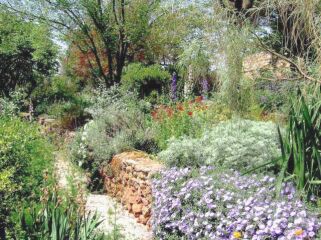
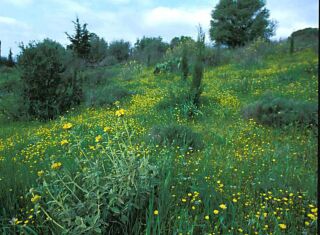
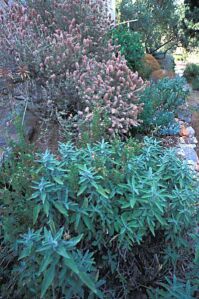
Views of the garden and hillside at Sparoza.
The MGS and the internet
The MGS operates five separate websites: the main site in English and smaller sites in Greek, French, Italian and Spanish. These are visited monthly by thousands of unique visitors, in the case of the main site, and hundreds of unique visitors in the case of the smaller sites. Regional branches have their own pages on the sites where they can advertise their programmes of events and report on past events.
You will find up to date information about the MGS and its organisation by clicking here.
The MGS Facebook page caters to the Facebook followers and some of the branches also maintain Facebook pages. The MGS Forum is where discussions about plants, gardens and gardening takes place with multiple postings every day from members and non-members alike. Member volunteers run all the many internet manifestations of the society. The websites and MGS Forum are managed by Jon Watts of Hereford Web Design.
Members
From the beginning it was envisaged that gardeners from all the mediterranean-climate regions of the world would want to participate in the MGS - from the countries surrounding the Mediterranean Sea, and from California, Australia and South Africa which, with humid winters and long hot and dry summers, have climates similar to that of the Mediterranean.
Although registered in Greece, the MGS uses English as its main language in order to be accessible to as many people as possible internationally. After a successful push to increase the number of members whose first language is not English, the Greek, French, Italian and Spanish websites mentioned above were set up to provide information about the MGS and about mediterranean gardening to speakers of these languages.
Members living in more northern climes join the MGS because of a general interest in mediterranean plants or because they have a second home and garden in a mediterranean area. Once a year a large number of members gather together for the Annual General Meeting which is accompanied by a few days of excursions. Old friends meet up and new friendships are made.
Branches
The Society has a number of active regional branches that independently plan their own activities ranging from lectures and demonstrations to garden visits and expeditions to areas of floral interest. Members visiting a different area are welcome to join in local events if places are available. The Branch Heads work both to provide an interesting programme of events for the members in their area, to promote the principles of the MGS among the general public and to encourage new members to join the MGS.
Officers
The Mediterranean Garden Society is administered entirely by volunteers, both at the central and at the branch levels. There is no paid staff; fees paid are for technical help in publishing the journal, managing the website and preparing the annual tax return for the tax office.
Membership
Membership to the MGS is open to all. Annual subscriptions are payable on 1st January and new members joining throughout the course of the year will receive all four issues published in that year. Joint membership at a reduced rate is available for partners who require only one journal and there is a reduced subscription for students.
Affiliated Societies
Hellenic Society for the Protection of Nature
Historic Gardens Review
Enrique Montoliu Foundation
Hortus
Kirstenbosch National Botanic Garden
Optima
Conservatoire & Jardin Botanique de da Ville Geneva
Arboretum, University of California
Indigenous Bulb Association
Royal Horticultural Society
Mediterranean Gardening Association Portugal
Members who would like to have a copy of the English translation of the MGS Charter, or who have any questions about the MGS, please get in touch with the secretary.
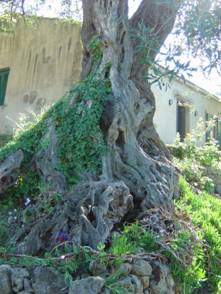
A garden on an olive tree.
Photographs by Fleur Pavlidis, Terry Moyemont,
Davina Michaelides and Michelle Torres-Grant.
|


